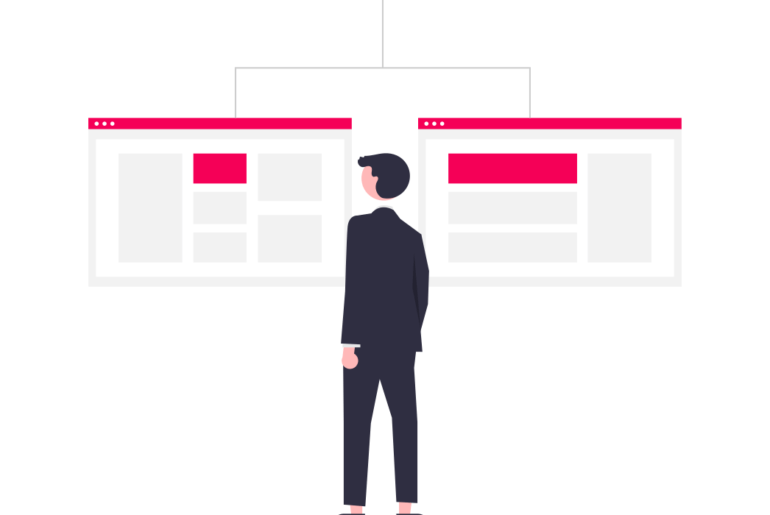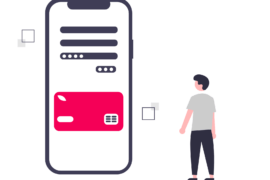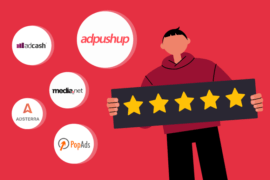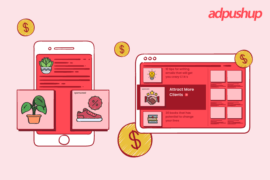Native ads are a popular choice amongst publishers because they lead to a better user experience, and in most cases, higher overall revenue.
Blending in with the medium in which they’re displayed, native ads help advertisers overcome banner blindness and ultimately help publishers earn more from their websites.
Business Insider Intelligence reports that the spending on native ads will reach $8 billion in 2015, and by 2018, this figure is projected to rise to $21 billion.
Social native ads, such as those seen on Facebook and Twitter, will account for the largest share of native ad revenue. It’s important to learn how to optimize your native ads so that they earn you more money now and in the future.
If you don’t fully understand native ads, learn all about them in our recent post.
What Are Native Ads?
You could ask 100 native advertising experts about native ads. And you’ll get 100 slightly different definitions.
If you listen carefully to each definition you hear, you will notice that they almost all have a core definition buried in there somewhere.
That core definition of what native ads goes something like this: Native ads are a form of advertising that matches and blends in with the medium it appears on. Ads use the same form as the content contained in the medium. For example, an ad can be a written article in the same format of editorial articles appearing in a magazine or on a website.
Simple, right? Keep reading for an even better understanding of what native ads are and how you can benefit from using them properly. By the way, here’s a list of some of the best native ad networks out there in case you were looking for that information.
Let’s start with a little journey through native ad history.
Also read: Native Advertising: Everything You Ever Wanted to Know
How to Optimise Native ads for Higher Revenue
Here are the different ways to optimize your native ads so that you can increase revenue:
1. Maximize the Relevance of Ads
You want the best for your readers. Right? Advertisers that display native ads want their ads to help their them make money and promote their brand, but you want these ads to be relevant to your audience above all else.
If you’ve written a post on gardening, your viewers wouldn’t expect an advertisement for apartments to be displayed.
These types of ads simply don’t convert well, and they harm the trust users put into your website. Relevancy will lead to trust and an increase in revenue. While it’s tempting to place native ads on a site, you need to ensure they’re relevant to your content.
How do you check ad relevancy?
Act as a user of your site. View your ads, and see if they’re relevant to the content produced or your audience’s needs. Testing different ad networks to find one that provides highly relevant native ads is always recommended.
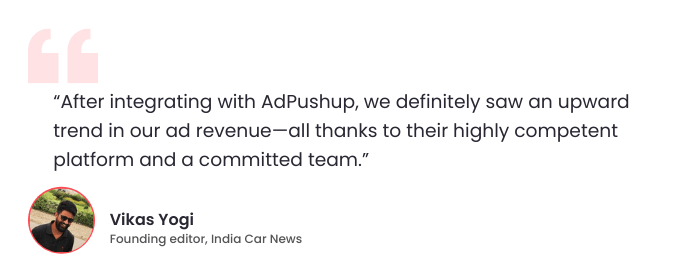
2. Rotate Multiple Ad Networks
Over time, visitors become blind to default ad positions and creatives, this leads to fewer clicks for the advertiser and lower revenue for the publisher. For this reason, advertisers are known to create several ads so that their campaigns never grows dull. As a publisher, a variety of different ad networks is the best way to promote engagement from your audience.
Readers of your website will notice ads that are newer or relevant to their needs. If an ad is being displayed everywhere from Facebook to a high-profile blog, your users may have already seen the ad and helped another publisher earn revenue as a result.
What do we recommend?
- Utilize several native ad networks at once.
- Rotate between networks to keep ads fresh.
Using ad rotation, you’ll limit the chance of users becoming blind to ads simply because they’ve seen the ad multiple times already.
3. Avoid Tricking Your Readers
Native ads are meant to blend into your content. They’re an extension of your content to inform or entertain the reader. Tricking users into clicking on these ads is unwise. Your readers are your website’s lifeline. If you trick them, they will not come back to your page – or at least not all of them.
As a publisher, delineate your native advertisements from the content on your site.
This sound counterproductive because native ads work so well, especially when they match your site’s content. But, you don’t want your user to think they’re clicking on your link, only to be directed to an advertiser. It may lead to a one-off conversion, but it may also result in one less return visitor to your site.
View your site from a visitor standpoint.
If an ad is misinterpreted to the point where a reader will click on it unintentionally, you’ll want to test out different ad placement options (we’ll discuss this shortly).
In-feed ads are the common culprits when tricking readers. If an ad matches the look and feel of content that it is placed in too well, it’s easy to see why the reader may click on the ad unknowingly.
4. Use Automation to Optimize Ads
Automation is a great way to optimize your website’s ads to see what works best for your audience. No, we’re not talking about doing anything deceptive. Automation, in the form of split testing, is a great way to find out what works for your site.
Every site will have a unique way to optimize and increase native ad revenue.
A common form of automation that publishers tend to ignore is split testing headlines.
Big businesses and news outlets will often test two or more story headlines using automation. The system will then automatically pick the headline that is receiving the most clicks to be displayed, leading to longer session times and higher ad engagement.
Automation can be a powerful tool in the optimization process.
You can test ad color and font variations as well as titles and creatives. When done automatically, you’ll be able to view metrics to see what works best for your audience.
Also read: Guide to Creating and Running Native Ads in Google Ad Manager
5. Optimize the Layout of Ad Units
Different ad layouts lead to better results. Testing all of these layouts or placements can be an extremely arduous task – especially on larger sites. Automation allows you to:
- Test pre-defined ad placements.
- Test different ad sizes and units.
- Track user behavior based on each layout.
Test, test and continue testing. This is how publishers will make the most money with any ad unit.
Automation allows you to find the layout that works best for your audience. Machine-learning driven optimization is now more robust than ever before. Based off of user behavior, these automated systems can continually optimize your site.
6. Use Content Recommendation Systems
In-feed ads may work well for your website, but adding more story views may provide the best revenue boost for your site. This doesn’t mean going out and writing more content, but it does mean adding more ways for users to navigate your site.
Taboola and OutBrain are two examples of this, and here are some more content recommendation systems.
Often placed directly under content, these “widgets” allow viewers to find stories from your site that are relevant or related as well as sponsored stories. For example, a 4-picture cube may be listed under a post where 2 cubes are a story from your site and 2 other cubes are sponsored stories.
This works to:
- Drive direct revenue through new ad opportunities.
- Redirect readers to other pages of your site.
It’s always better for a reader to remain on your site than click “x” and move on to something else. Redirecting traffic to other, relevant pages of your site provides another opportunity to earn revenue.
The sponsored stories also perform very well with revenues based on a per-click basis.
Visually appealing, these networks offer a fluid design that blends perfectly with your website’s look and feel.
7. Test CPC vs CPM vs CPA vs Direct Sales
Something you should be doing with all of your advertisements is trying out different ad types to see which produces the most revenue. This can be done with the following:
- CPC: The cost-per-click model works well for a lot of websites that are content-heavy. Sites that contain imagery or videos tend to do better with the CPM model.
- eCPM: This refers to earnings per 1,000 impressions. A great way to earn money even when users aren’t engaging with an ad, a CPM payment model is ideal for larger sites with a lot of traffic.
- CPA: Cost-per-action is often associated with affiliate marketing. You may lead a visitor to sign up for a free sample of a teeth whitening product you recommended and will make money when they provide their information to the company.
Selling ad space directly to publishers is the most lucrative option for publishers. When you sell ads directly, you can negotiate the terms. In most cases, you will sell space based on CPM, but you can choose a CPA or CPC option as well.
Mixing various ways you’re paid for ads is a good way to increase overall revenue and squeeze every penny out of the traffic you receive.
Native ads are just like all other ads where testing is vital to your overall revenue. The one major difference is that you’ll want to pay close attention to your layout to ensure you’re not tricking your readers into clicking ads.
Frequently Asked Questions:
Native advertising is a form of advertising that blends in with the medium it appears on. Ads use the same form as the content contained in the medium.
Mobile native advertising is same as the desktop native advertising. It is comprised of social media ads, in-feed ads, sponsored content, and more. They are non-intrusive, and viewed three times more often than banner ads.
Usually, native ads are better received by the target audiences since they help combat ad fatigue and also boost audience engagement. Since native ads don’t feel like advertisement, people are more inclined to view them.

Shubham is a digital marketer with rich experience working in the advertisement technology industry. He has vast experience in the programmatic industry, driving business strategy and scaling functions including but not limited to growth and marketing, Operations, process optimization, and Sales.
